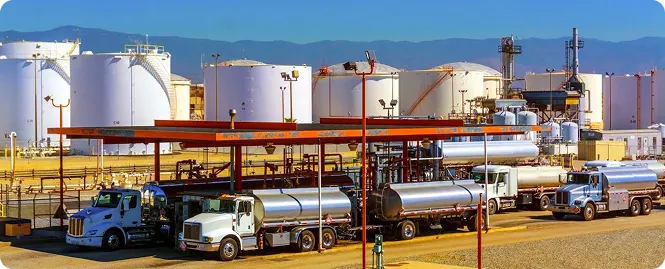How to Open a Gas Station in Virginia
Table of Contents
Key Takeaways
-
Conduct a market analysis to identify high-traffic areas with strong demand. Evaluate local competition, zoning laws, and accessibility to ensure long-term profitability.
-
To attract investors and lenders, a well-structured business plan should outline startup costs, profit margins, and funding options such as a business loan or small business administration (SBA) programs.
-
Obtain the necessary permits, licenses, and insurance. Setting up a limited liability company (LLC) and securing general liability insurance helps protect your gas station business from potential risks.
-
Explore business credit cards, investor partnerships, and loan options to fund gas pumps, fuel storage tanks, and convenience stores. Choosing reliable suppliers and negotiating contracts ensures smooth operations.
-
Attract customers with grand opening promotions, loyalty programs, and social media marketing. Consistently maintain facilities, monitor profit margins, and adapt to market trends to sustain a successful gas station business.
Virginia’s gas station industry offers lucrative opportunities for business owners looking to tap into a high-demand market. With high-traffic areas, a steady influx of commuters, and growing suburban development, opening a gas station in Virginia can generate substantial profit margins. However, success may depend on factors like location, fuel pricing strategies, and additional services such as convenience stores or car washes. A well-planned approach can turn a gas station into a thriving and profitable business.
Starting a gas station business is more than just setting up gas pumps and selling fuel. It requires navigating permits, financing, market analysis, and business structure decisions which can include forming a limited liability company (LLC). Understanding startup costs, legal requirements, and operational strategies is essential in order to achieve long-term success. A well-researched plan can help ensure a smooth launch along with sustainable growth, helping gas station owners maximize revenue while avoiding costly mistakes.
Step 1: Researching the Market and Location
When opening a gas station in any area, the location can make or break your success. You want a spot with steady traffic, easy access, and high visibility. Busy highways, major intersections, and growing neighborhoods are prime locations. Being near shopping centers, business hubs, or residential communities means more foot traffic and repeat customers. Don’t just think about cars—consider walk-ins too. A convenience store or additional services can turn a quick fuel stop into a profitable visit.
It’s not just about picking a spot—it’s about picking the right spot. Conduct thorough research on the current local demand and figure out where drivers prefer to stop for gas. High traffic doesn’t always mean high sales if competitors are in close proximity. Check out gas prices, services, and customer preferences in the area. If another station dominates, think about what you can do better—maybe lower prices, provide top-tier service, or a loyalty rewards program.
Drivers in Virginia aren’t all the same—some want the cheapest gas, while others look for premium fuel and a clean, well-stocked convenience store. Depending on your area, you might attract customers looking for EV charging stations, car washes, or quick auto services. Knowing your audience means keeping them coming back!
Step 2: Creating a Business Plan
A solid business plan is the foundation of running a successful gas station. It serves as a roadmap that helps you navigate through startup costs, operational expenses, and profitability expectations. Investors and lenders want to see a clear strategy, so your plan should clearly outline market demand, competitive advantages, and potential challenges. Whether you're launching an independent station or a franchise, having a well-thought-out plan ensures you stay on track and make informed business decisions.
A comprehensive gas station business plan should cover details such as financial projections, revenue goals, and marketing strategies. Document your startup costs, funding sources, and expected profit margins from your business. Outline clever strategies for attracting customers, whether through loyalty programs, promotional offers, or collaborative partnerships. Don’t forget about staffing, inventory management, and regulatory compliance—these factors have a huge impact on daily operations. A well-structured plan helps secure business loans and keeps your station profitable.
Success doesn’t just follow opening your doors; it comes by staying competitive in the game and expanding. Outline plans for scaling your business, whether through adding convenience store services, investing in EV charging stations, or opening up additional locations. Take long-term financial stability, market shifts, and emerging fuel trends into account while planning. A forward-thinking strategy not only ensures sustainability but also positions your gas station as a profitable, customer-focused business in Virginia.
Step 3: Legal and Regulatory Requirements
Before you can start pumping gas, you will need to obtain the necessary permits, licenses, and registrations. This includes a business license, fuel sales permits, and environmental clearances. Gas station owners must also register with state and federal agencies for tax and compliance purposes. If you plan to sell lottery tickets, tobacco, or alcohol, additional permits are required. Navigating the paperwork may seem overwhelming, but securing the right approvals is key to avoiding legal roadblocks.
Virginia has strict zoning laws that help establish where gas stations can operate. High-traffic areas may be ideal, but you must ensure your location meets zoning and land-use requirements. Some regions limit how close gas stations can be built to schools, residential areas, and water sources. Additionally, local authorities may require site plan approvals, safety inspections, and adherence to signage and advertising restrictions. A thorough market analysis can help owners identify profitable locations.
Gas stations deal with hazardous materials, which makes complying with environmental laws a top priority. You must follow fuel storage, spill prevention, and waste disposal regulations. The state enforces strict underground storage tank (UST) requirements to prevent contamination. Regular inspections, leak-detection systems, and emergency response plans are mandatory. Failure to comply with EPA and Virginia DEQ regulations can result in hefty fines. Staying proactive with safety and environmental protocols helps ensure long-term business success.
Step 4: Securing Financing
Starting a gas station can require significant investment; to help with that, several financing options are available. Many business owners secure funding through traditional bank loans, Small Business Administration (SBA) loans, or private investors. Some companies offer financing assistance if you’re considering a gas station franchise. Business credit cards and alternative lending sources can also help cover startup costs. A strong business plan and market analysis increase your chances of securing funds from reputable lenders.
Make sure that your financial documents are in order before applying for a loan or pitching it to investors. This includes income statements, projected profit margins, tax returns, and startup cost estimates. Before offering financial backing, lenders and investors will assess your creditworthiness, business plan, and risk factors. A detailed revenue model and a clear strategy for repaying loans or providing investor returns strengthen your case. A well-prepared financial pitch boosts confidence in your venture.
Virginia offers several state and federal programs that help small business owners make their place in the market. These include SBA-backed loans, local economic development grants, and tax incentives. Programs like the Virginia Small Business Financing Authority (VSBFA) provide funding assistance for eligible businesses. Additionally, minority-owned and veteran-owned businesses may qualify for special grants. Researching and applying for these programs can further reduce financial strain and provide crucial funding to open a gas station successfully.
Step 5: Selecting the Right Equipment and Suppliers
A fully functional gas station requires the right equipment to operate efficiently. Fuel dispensers, underground storage tanks, and point-of-sale (POS) systems are the backbone of your business. Investing in high-quality pumps, leak detection systems, and automated payment solutions ensures smooth transactions and safety. Additionally, installing security cameras, air compressors, and signage further enhances the customer experience. Prioritizing energy-efficient and modern equipment can also help reduce maintenance costs and improve profit margins in the long run.
Partnering with reliable fuel suppliers can help you maintain consistent fuel quality and competitive pricing. Consider whether you want to operate as an independent station or join a gas station franchise, as this has an impact on your supplier options. Negotiating favorable contracts, delivery schedules, and wholesale fuel rates can maximize profits. Keeping an eye on fuel market trends and developing relationships with multiple suppliers ensures you are never left without stock during high-traffic periods.
A gas station is more than just fuel—it’s an opportunity to offer convenience and value-added services. Setting up a convenience store, car wash, or auto repair service can significantly boost revenue. Selling snacks, drinks, and essential car accessories attracts more customers, while services like tire inflation and oil changes increase foot traffic. Business owners who diversify their offerings and strategically place convenience stores in high-demand areas create a one-stop shop for commuters and locals alike.
Step 6: Building and Designing the Gas Station
Constructing a gas station requires careful planning to ensure both efficiency and visual appeal. The layout should optimize traffic flow, fueling areas, and parking spaces to create a seamless driver experience. A well-designed convenience store can significantly increase revenue, offering grab-and-go snacks, beverages, and essential car supplies. Strategic placement of signage, lighting, and entry points improves visibility and attracts more customers. Incorporating eco-friendly elements, such as solar panels or energy-efficient lighting, can lower operational expenses.
Safety should always come first when designing a gas station and convenience store. Compliance with local building codes, fire regulations, and environmental standards is vital in order to avoid legal issues or penalties. Proper ventilation, spill containment systems, and emergency shut-off valves help prevent accidents. Additionally, ADA-compliant ramps, well-lit walkways, and accessible restrooms ensure inclusivity for all customers. Regular inspections and staff training on emergency response procedures can further enhance overall safety and operational reliability.
A welcoming gas station focuses on providing an excellent customer experience. A welcoming design and fast service can turn one-time visitors into loyal customers. Clean, well-lit, and organized space with a wide entrance, clear signage, and intuitive pump placement make fueling easy, while a well-stocked convenience store provides added value.
Step 7: Hiring and Training Employees
Hiring the right employees is crucial for running a successful gas station. To keep operations smooth, you need friendly customer service representatives, efficient managers, and skilled maintenance staff. Look for reliable, hardworking individuals with experience in retail, fuel handling, or hospitality. Consider conducting background checks and thorough interviews to ensure trustworthiness. Offering competitive wages, flexible shifts, and growth opportunities can help attract and retain top talent. A well-staffed station enhances both efficiency and customer satisfaction.
Proper employee training is non-negotiable in the gas station business. Staff should be well-versed in fuel safety protocols, emergency procedures, and cash handling. Providing proper customer service training helps ensure your employees can handle inquiries, complaints, and sales professionally. Regular safety drills can also prepare them for fire hazards, fuel spills, and security risks. Investing in ongoing training and refresher courses improves efficiency, reduces liability, and creates a well-rounded, knowledgeable workforce ready for any situation.
A well-organized scheduling and payroll system keeps operations running smoothly. Automated scheduling software helps balance shifts, prevent overstaffing, and ensure a fair distribution of workload. A transparent payroll system with direct deposits and tax compliance simplifies salary processing. Efficient workforce management keeps employees happy and minimizes disruptions, providing consistent service and productivity.
Step 8: Marketing and Promotion
Launching a gas station is exciting, but getting people through the doors requires clever local marketing. You can start with eye-catching signage, grand opening discounts, and direct mail flyers. Leverage radio ads, billboards, and local newspapers to reach nearby drivers. Hosting a grand opening event with freebies, fuel discounts, and giveaways can create buzz. Partnering with community influencers and local media outlets can further amplify visibility, ensuring your gas station becomes a well-known stop in town.
Social media can become a game-changer for marketing your gas station in today's digital age. Create pages on Facebook, Instagram, and Google My Business to build engagement with potential customers. Offer limited-time fuel discounts, promotional deals on convenience store items, and loyalty reward programs to encourage more repeat visits. Running targeted online ads can help reach the drivers in the area, while user-generated content, check-in rewards, and referral bonuses further drive engagement and long-term loyalty.
A gas station thrives on local support and collaborations. Partner up with nearby businesses, schools, and charities to build trust and further increase exposure to the community. Sponsoring events, sports teams, or fundraisers boosts credibility. Cross-promotions with restaurants or auto shops drive mutual traffic, making your station a go-to stop for locals.
Step 9: Ongoing Operations and Maintenance
Running a gas station isn’t just about selling fuel—it’s about keeping everything flowing like a well-oiled machine. Every detail matters, from managing inventory and tracking fuel prices to ensuring your shelves are stocked with fresh snacks and essentials. Pricing should be competitive yet profitable, and a smooth customer experience is key. A little efficiency goes a long way—so train your staff well, keep lines moving, and stay ahead of market trends to maximize profit margins.
A gas station should be safe, clean, and compliant—anything less is a disaster waiting to happen. Practices such as regular equipment checks, leak prevention measures, and emergency protocols help keep things running smoothly. Staying on top of state and federal regulations isn’t just a legal requirement; it builds customer trust. Additionally, a well-lit station with spotless restrooms and secure payment systems will make your gas station pop out instead of the one customers avoid.
Your customers will tell you exactly what they need—if you listen closely. Encourage feedback through surveys and online reviews, and use it to fine-tune your future operations. Whether it’s better product selection, pricing adjustments, or improved service, small tweaks can turn one-time visitors into loyal customers who keep coming back.
Conclusion
Launching a gas station in Virginia is a big investment requiring strategic decision-making. Every step, from securing permits to managing daily operations, helps in securing long-term success. A prime location, solid funding, and effective marketing can help your business thrive. Staying proactive and adaptable will keep you ahead of challenges.
Having the right insurance coverage is essential for keeping your business protected. General liability, workers’ compensation, and property insurance protect against risks which include property damage, fuel spills, and customer accidents. With the right policies in place, you can minimize financial setbacks and focus on growing your business with confidence.










